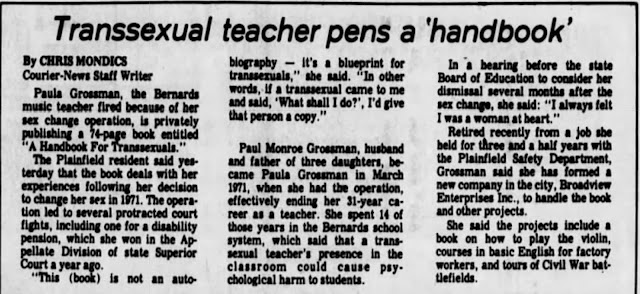The book consists of two poems, an introduction with a bibliography co-signed by the two editors, 20 autobiographical essays, two brief accounts of genital reconstruction surgery, two typology diagrams, a second bibliography and a glossary.
What is the name of the first editor? On the title page it is given as J. Ari Kane-
Demaios. However the Introduction refers to an Ariadne Kane who is presumably the same as the Ariadne Maria Kane given as the name of the author of the second essay. Readers with external knowledge may know that these are all one person. However this is not clarified for readers not already in the loop. Furthermore, in the essay by Christopher Barrett (#6) he pays for counselling from a Dr Ari Kane (p 97), presumably yet again the same person. In addition the two accounts of surgery are by Ariadne Kane and the two typologies are by J. Ari Kane-
Demaios. This is surely quite confusing for any readers with no acquaintance with the person. At the very least an editorial note on this issue would have been sensible.
In contradistinction to standard academic practice, the two editors append their doctorates to their names on the title page, and again on the surgical accounts and the typologies. The same courtesy is not extended to the authors of the autobiographical essays, some of whom do in fact have higher degrees, and one of whom,
Esben Benestad, is an MD and has important publications in sexology and psychology.
The introduction signed by both editors, would actually seem to be by Vern
Bullough alone, and is a condensation of his
Cross Dressing, Sex, and Gender. This assumption also explains why there are two bibliographies, the one at the end of the book being Kane’s.
Both Kane and
Bullough are admitted followers of
Virginia Prince.
Bullough’s
Cross Dressing, Sex and Gender has been criticized for giving too much emphasis to Prince and ignoring other
transgender activists. This new book repeats this by having 10 – far too many - of the 20 essays by organizers of
Princian-style groups. Prince herself, and the groups that she founded, have been criticized for excluding gays, transsexuals, drag performers and all female-to-male
transgenders. They also promoted a middle-class respectability at odds with the less conformist models of
transgenderism, and apparently also to working class and ethnic minority
transgenders. Sex workers in particular were not welcome. In addition, the questioning of sex roles by feminism, the gay movement, and gender theory is pretty well non-existent. And there is an indifference to what happens outside the US.
Bullough’s introduction fails to mention anything at all outside the US after
Jorgensen comes back from Denmark. The
Princian groups have relaxed two of their restrictions: transsexuals are now permitted, as are female-to-male persons.
The selection is this book reflects this exclusivity quite closely. Of the 20 essays, one is by a Norwegian, but 19 by US persons. Only two are by female-to-males. This gender bias is reflected in the cover illustration of a male sifting through a hourglass to become female. 19 (including the 2
FTMs) of the persons are
gynephilic (sexually oriented to females), and one, who after an early
gynephilic marriage, takes a secretive male lover. There are no
androphilic persons (sexually oriented to males) as such. All 20 persons have middle-class occupations (doctor, professor, teacher, nurse, financial advisor, own business etc). No-one works in
Wal-Mart, or a factory or drives a taxi (although a couple have been through rough periods when they could not get work). No-one is on welfare, and no-one is a criminal, no-one is a sex-worker, and no-one has been murdered. No-one is black, or Latina or Asian. No-one is an immigrant. No-one works in a drag show, or gets off on gender
transgressivity – although one writer, Christine
Hochberg, is in that generally-ignored category, the heterosexual drag queen. No-one is a butch female or female-
masculinist. All write reasonably well. Thus we can say that the sample is strongly atypical, both of the general population and of transgender persons.
Kane, who, like an old-time female-impersonator, prefers to be addressed by male pronouns, in his own autobiographical essay says that when he first went to a
transy group, the organizer reassured him: “She added that many of the members came from middle-class environments, had respectable jobs, and were married in the traditional sense.” (p49). And so are most of the persons here.
Many of the writers are pushing the definition of same-sex marriages by becoming legally female while still married to woman. Do any of them relate this to the debate in the US re same-sex marriages, or to the concept of being gender queer? Helen Boyd and Phyllis Frye do, but not the others.
The two female-to-male persons are the only ones to become ‘heterosexual’ in their new genders. None of the male-to-females do. This is the greatest distortion in the book. There is no shortage of such persons, and yet the editors of this book were unable to find even one.
Worse still, this book could be taken as a companion to
Michael Bailey’s hateful
The Man who would be Queen. By excluding what Bailey tendentiously refers to as ‘homosexual transsexuals’, this book – consciously or not – endorses his viewpoint by presenting only
transgenders who fit his concept of ‘
autogynephiles’ – that is oriented to women, professional, respectable etc. See my
article on
Autogynephilia.
This said, I would like to commend some of the essay writers for having produced good, readable, succinct, interesting autobiographies, but they are betrayed by the editors and their biased selection.
I would refer prospective readers instead to
Finding the Real Me edited by Tracie O’Keefe and Katrina Fox, and
Genderqueer edited by Joan Nestle, Clare Howell and Riki
Wilchins, both of which present a much more representative sample of transgender lives.



























